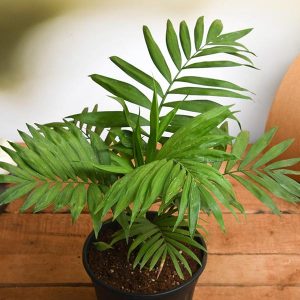Description
A mango is a juicy stone fruit produced from tropical trees belonging to the flowering plant genus Mangifera, and family Anacardiaceae, cultivated mostly for their edible fruit and it is originated in India. The Alphonso is a seasonal fruit, available mid-April through the end of June.
The fruits generally weigh between 150 and 300 grams sometimes vary. Alphonso mangos have a rich, creamy, tender texture and delicate, non-fibrous, juicy pulp.
The skin of a fully ripe Alphonso mango turns bright golden-yellow with a tinge of red which spreads across the top of the fruit. The flesh of the fruit is saffron-colored. These characteristics makes the Alphonso favorite fruit of India.
Plant Specifications
| Plant Height | 25 inch (64 cm) |
| Plant Spread | 7 inch (18 cm) |
*above specification are indicative only. actual dimensions may vary by +-10%
| Common Name | Hafoos, Hapuz, Aapoos, Mango, Aam. |
| Maximum Reachable Height | Up to 10 meter |
| Flower Colour | Whitish green |
| Bloom Time | December-January. |
| Difficulty Level | Easy |
Planting And Care
Sunlight
- Sunlight of more than 6 hours a day is ideal for flowering and fruit development of mango plant.
Soil
- The soil should be well drained, fertile and rich in organic content.
Watering
- Poke your finger/plain small stick into the soil to check the moisture.
- Apply 4 cup(approx. 200 ml) of water when the top soil (1-2 inch) in the pot feels dry to touch.
- Do not overwater the plant.
- As a rule of thumb, water the plants thoroughly in summer and reduce watering in winter and rainy season.
- Water should be applied preferably in the morning or evening.
Application of Fertilizer
- Before application of fertilizer loosen the topsoil without disturbing the roots of the plant so, it can uptake the nutrients and moisture easily.
- Apply organic fertilizer once a month during the main growing season (December-February)
- Apply water immediately after application of fertilizer.
Re-potting
- When a plant outgrows in current pot, re-pot with fresh potting soil and some fertilizer.
- Do the re-potting late evening and keep the plant in shady area for 2 to 3 days and then move the plant in its suitable climatic condition.
Plant Protection
- Remove dead, infected or damaged plant parts and discard them away from the plants.
- For any insect attack or disease, you can use Neem oil, Eucalyptus oil or Citrus oil spray for primary treatment.
Donts
- Do not over-water the plant especially when pot does not have drainage holes.
Mango Tree Care
Initial care for 1-2 weeks after receiving plant at your location:
- Poke your finger/plain small stick into the soil to check the moisture.
- Apply 4 cup(approx. 200 ml) of water when the top soil (1-2 inch) in the pot feels dry to touch.
- Keep the plant in natural indirect bright light.
- Do not re-pot for min. 2 weeks after receiving it.
Key requirements to keep plant healthy:
| Sunlight | Natural bright light with direct sunlight more than 6 hours a day. |
| Watering | Apply 4 cup(approx. 200 ml) of water when the top soil (1-2 inch) in the pot feels dry to touch |
| Soil | Well drained, fertile and rich in organic content. |
| Temperature | 20-38 degree Celsius. |
| Fertilizer | Apply organic fertilizer once a month specially during main growing season(December-February) |
| Harvest Season | Summer(mid April-June) |
Mango Tree Special Feature
Mango delicious taste, excellent flavor and attractive fragrance, it is rich in vitamins A and C.
Mango Tree Uses
Ornamental Use:
- Mango plants can be used in the garden for shade as well as ornamental purposes
Medicinal Use:
- Alphonso mango rich in vitamin A
- Mango young leaves are very useful for managing diabetes
- It lowers blood pressure
- Mango plant is also helpful in Treats gall and kidney stones
- Note: The above information is general guidelines, be sure to consult your healthcare adviser for consumption or application for medicinal purpose
Culinary Use:
- Mango fruit is utilised at both the stages of its development in its immature and mature state
- Raw fruits are used for making chutney, pickles and juices
- The ripe fruits besides being used for dessert are also utilised for preparing several products like squashes, syrups, nectars, jams and jellies





Reviews
There are no reviews yet.